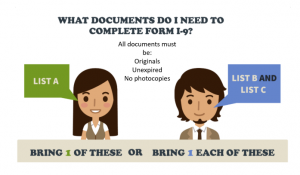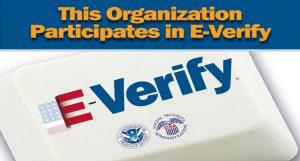Background:
In 1986, Congress reformed U.S. immigration laws to preserve the tradition of legal immigration while seeking to close the door to illegal entry
The employer sanctions provisions, found in section 274A of the Immigration and Nationality Act (INA), were added by the Immigration Reform and Control Act of 1986 (IRCA)
These provisions further changed with the passage of the Immigration Act of 1990 and the Illegal Immigration Reform and Immigrant Responsibility Act (IIRIRA) of 1996
Why Employers Must Verify Employment Authorization and Identity of New Employees?
The purpose of the employer sanctions law is to implore employers to hire only individuals who may legally work here: U.S. citizens, noncitizen nationals, lawful permanent residents, and aliens authorized to work. To comply with the law, employers must:
- Verify the identity and employment authorization of each person they hire
- Complete and retain a Form I-9, Employment Eligibility Verification, for each employee
- Refrain from discriminating against individuals based on nationality or citizenship
You can download Form I-9 (PDF) (PDF, 726.73 KB) and the instructions (PDF, 355.87 KB) on the USCIS website at uscis.gov/i-9-central. You may also order paper forms at uscis.gov/forms/forms-by-mail or by calling the USCIS Contact Center at 800-375-5283 (TTY: 800-767-1833). You must use the current version of Form I-9 found at uscis.gov/i-9. A revision date with an “N” next to it indicates that all previous versions with earlier revision dates are no longer valid.
Note: Form I-9 is available in English and Spanish. Employers in the United States and its territories may use the Spanish version of Form I-9 as a translation guide for Spanish-speaking employees but must complete and retain the English version. Employers in Puerto Rico may use either the Spanish or the English version of Form I-9.
Who Must Complete Form 1-9 Documents?
- You must complete Form I-9 each time you hire any person to perform labor or services in the United States in return for wages or other remuneration
- Remuneration is anything of value given in exchange for labor or services, including food and lodging
- The requirement to complete Form I-9 applies to new employees hired in the United States after Nov. 6, 1986, as well as new employees hired in the Commonwealth of the Northern Mariana Islands (CNMI) on or after Nov. 28, 2009
For Employees:
- Please Ensure the employee completes Section 1 of Form I-9 at the time of hire
- “Hire” means the beginning of employment in exchange for wages or other remuneration
- The time of hire is noted on the form as the first day of employment
- Employees may complete Section 1 before the time of hire, but not before the employer extends the job offer and the employee accepts
- Review the employee’s document(s) and fully complete Section 2 within three business days of the hire. For example, if the employee begins employment on Monday, you must complete Section 2 by Thursday
What Documents from Employees are Acceptable?
An employee must present a document or combination of documents from List A (which shows both identity and employment authorization) or one document from List B (which shows identity) and one document from List C (which shows employment authorization) or an acceptable receipt of those documents within three business days of the date work for pay begins.
Some Rules You Should Follow about Acceptable Documents:
- The employee that presents a receipt must present the actual document when the receipt validity period ends, or when they receive the document, whichever comes first
- Do not require an employee who presents a List A document to present List B and List C documents
- Do not require an employee who presents List B and List C documents to present a List A document
- You cannot accept a receipt showing the employee has applied for an initial grant of employment authorization
- You also cannot accept receipts if employment is for less than three business days
- For a list of acceptable receipts for Form I-9, see Table 1 in Section 4.3, Acceptable Receipts. For examples of acceptable employment authorization documents issued by the Department of Homeland Security (List C #7), please visit gov/i-9-central
LIST A: Documents That Establish Both Identity and Employment Authorization
All documents must be unexpired.
- U.S. passport or U.S. passport card
- Form I-551, Permanent Resident Card or Alien Registration Receipt Card (this is commonly called a Green Card.) See Section 6.1, Lawful Permanent Residents for when a Permanent Resident Card is considered unexpired past the “Card Expires” date.
- Foreign passport that contains a temporary I-551 stamp or temporary I-551 printed notation on a machine-readable immigrant visa (MRIV)
- Form I-766, Employment Authorization Document (EAD) that contains a photograph. However, in certain circumstances, an EAD past its “Card Expires” date qualifies as an unexpired EAD. See Section 4.4, Automatic Extensions of Employment Authorization Documents in Certain Circumstances, for more information.
- For nonimmigrant aliens authorized to work for a specific employer incident to status, which means they are authorized to be employed based on their nonimmigrant status, a foreign passport with Form I-94 bearing the same name as the passport and an endorsement of their nonimmigrant status, as long as the period of endorsement has not yet expired and the proposed employment is not in conflict with any restrictions or limitations identified on the form
- Passport from the Federated States of Micronesia (FSM) or the Republic of the Marshall Islands (RMI) with Form I-94 indicating nonimmigrant admission under the Compact of Free Association Between the United States and the FSM or RMI
LIST B: Documents That Establish Identity
All documents must be unexpired.
- Driver’s license or ID card issued by a state or outlying possession of the United States provided it contains a photograph or information such as name, date of birth, gender, height, eye color, and address
- ID card issued by federal, state, or local government agencies or entities, provided it contains a photograph or information such as name, date of birth, gender, height, eye color, and address (This selection does not include the driver’s license or ID card issued by a state or outlying possession of the United States in Item 1 of this list.)
- School ID card with a photograph
- Voter’s registration card
- U.S. military card or draft record
- Military dependent’s ID card
- U.S. Coast Guard Merchant Mariner Card
- Native American tribal document
- Driver’s license issued by a Canadian government authority
For persons under age 18 who are unable to present a document listed above:
- School record or report card
- Clinic, doctor, or hospital record
- Daycare or nursery school record
LIST C: Documents That Establish Employment Authorization
All documents must be unexpired.
- A Social Security Account Number card, unless the card includes one of the following restrictions:
- NOT VALID FOR EMPLOYMENT
- VALID FOR WORK ONLY WITH INS AUTHORIZATION
- VALID FOR WORK ONLY WITH DHS AUTHORIZATION
- Certification of the report of birth issued by the U.S. Department of State (Forms DS-1350, FS-545, FS-240)
- Original or certified copy of a birth certificate issued by a state, county, municipal authority, or outlying territory of the United States bearing an official seal
- Native American tribal document
- Form I-197, U.S. Citizen Identification Card
- Form I-179, Identification Card for Use of Resident Citizen in the United States
- Employment authorization document issued by the Department of Homeland Security. For more examples, please visit gov/i-9-central. (This does not include Form I-766, Employment Authorization Document, from List A.)
You Might Also Want to Consider E-Verify Program:
- E-Verify is a voluntary program
- However, employers with federal contracts or subcontracts that contain the Federal Acquisition Regulation (FAR) E-Verify clause are required to enroll in E-Verify as a condition of federal contracting
- E-Verify is available in all 50 states, the District of Columbia, Puerto Rico, Guam, the U.S. Virgin Islands, and the Commonwealth of Northern Mariana Islands, is currently the best means available to electronically confirm the employment eligibility
What Exactly is E-Verify?
E-Verify is an Internet-based system that compares information entered by an employer from an employee’s Form I-9, Employment Eligibility Verification, to records available to the U.S. Department of Homeland Security and the Social Security Administration to confirm employment eligibility.
What Are the Benefits of E-Verify?
- E-Verify operates with speed and accuracy
- E-Verify is the only free, fast, online service of its kind that electronically confirms an employee’s information against millions of government records and provides results within as little as three to five seconds
- Has over 967,000 enrolled employers of all sizes
- Includes more than 2.4 million hiring sites
- Is joined by about 1,500 new participating companies every week
- Is one of the federal government’s highest-rated services for user satisfaction
Note: you should take care to avoid E-Verify misuse. As some types of misuse may leave the employer subject to legal action
You can find more about E-Verify Compliance here
Consider hiring an experienced immigration attorney to assist you in this process of E-Verify Compliance
You can fill out this contact form and schedule your consultation with one of our attorneys, or
Schedule a Consultation 469-994-9407 to discuss your options.



